Emerald ash borer
The emerald ash borer (Agrilus planipennis), also known by the acronym EAB, is a green buprestid or jewel beetle native to north-eastern Asia that feeds on ash species. Females lay eggs in bark crevices on ash trees, and larvae feed underneath the bark of ash trees to emerge as adults in one to two years. In its native range, it is typically found at low densities and does not cause significant damage to trees native to the area. Outside its native range, it is an invasive species and is highly destructive to ash trees native to Europe and North America. Prior to being found in North America, very little was known about emerald ash borer in its native range; this has resulted in much of the research on its biology being focused in North America. Local governments in North America are attempting to control it by monitoring its spread, diversifying tree species, insecticides, and biological control.
| Emerald ash borer | |
|---|---|
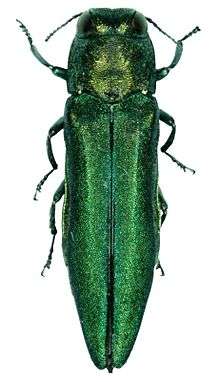 | |
| Scientific classification | |
| Kingdom: | Animalia |
| Phylum: | Arthropoda |
| Class: | Insecta |
| Order: | Coleoptera |
| Family: | Buprestidae |
| Genus: | Agrilus |
| Species: | A. planipennis |
| Binomial name | |
| Agrilus planipennis Fairmaire, 1888 | |
| Synonyms | |
| |
History
French priest and naturalist Armand David collected a specimen of the species during one of his trips through imperial China in the 1860s and 1870s. He found the beetle in Beijing and sent it to France, where the first brief description of Agrilus planipennis by the entomologist Léon Fairmaire was published in the Revue d'Entomologie in 1888.[2] Unaware of Fairmaire's description, a separate description naming the species as Agrilus marcopoli was published in 1930 by Jan Obenberger.[2]
Identification
Adult beetles are typically bright metallic green and about 8.5 millimeters (0.33 in) long and 1.6 millimeters (0.063 in) wide. Elytra are typically a darker green, but can also have copper hues. Emerald ash borer is the only North American species of Agrilus with a bright red upper abdomen when viewed with the wings and elytra spread. The species also has a small spine found at the tip of the abdomen and serrate antennae that begin at the fourth antennal segment.[3] Adults beetles of other species can often be misidentified by the public.[4][5]
Life cycle
The emerald ash borer life cycle can occur over one or two years depending on the time of year of oviposition, the health of the tree, and temperature.[6]
After 400–500 accumulated degree-days above 10 °C (50 °F), adults begin to emerge from trees in late spring, and peak emergence occurs around 1,000 degree-days. After emergence, adults feed for one week on ash leaves in the canopy before mating, but cause little defoliation in the process.[7] Males hover around trees, locate females by visual cues, and drop directly onto the female to mate. Mating can last 50 minutes, and females may mate with multiple males over their lifespan.[8] A typical female can live around six weeks and lay approximately 40–70 eggs, but females that live longer can lay up to 200 eggs.[7]
Eggs are deposited between bark crevices, flakes, or cracks and hatch about two weeks later. Eggs are approximately 0.6 to 1.0 millimeter (0.02 to 0.04 in) in diameter, and are initially white, but later turn reddish-brown if fertile.[7][6] After hatching, larvae chew through the bark to the inner phloem, cambium, and outer xylem where they feed and develop.[8] Emerald ash borer has four larval instars. By feeding, larvae create long serpentine galleries. Fully mature fourth-instar larvae are 26 to 32 millimeters (1.0 to 1.3 in) long.[6] In fall, mature fourth-instars excavate chambers about 1.25 centimeters (0.49 in) into the sapwood or outer bark where they fold into a J-shape.[8] These J-shaped larvae shorten into prepupae and develop into pupae and adults the following spring. To exit the tree, adults chew holes from their chamber through the bark, which leaves a characteristic D-shaped exit hole. Immature larvae can overwinter in their larval gallery, but can require an additional summer of feeding before overwintering again and emerging as adults the following spring.[6] This two-year life cycle is more common in cool climates, such as European Russia.[9]
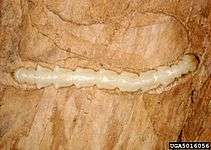 Larva
Larva Pupa removed from its pupal chamber.
Pupa removed from its pupal chamber. Adults exit the tree from D-shaped holes.
Adults exit the tree from D-shaped holes.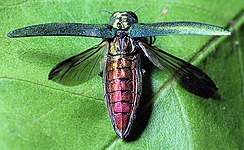 Dorsal view of adult with elytra and wings spread.
Dorsal view of adult with elytra and wings spread.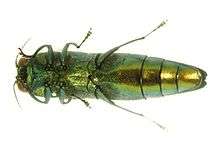 Underside of an adult emerald ash borer.
Underside of an adult emerald ash borer.
Range

The native range of the emerald ash borer is temperate north-eastern Asia, which includes Russia, Mongolia, northern China, Japan, and Korea.[10][9]
The beetle is invasive in North America where it has a core population in Michigan and surrounding states and provinces. Populations are more scattered outside the core area, and the edges of its known distribution range north to Ontario, south to northern Louisiana, west to Colorado, and east to Massachusetts.[11] In eastern Europe, a population was found in Moscow, Russia, in 2003.[9] From 2003 to 2016, this population has spread west towards the European Union at up to 40 km (25 mi) per year and is expected to reach central Europe between 2031 and 2036.[12][13][9] Although not recorded from the European Union as of 2019, it has already spread to far eastern Ukraine from neighboring Russia.[14][15][16][17]
Host plants
In its native range, emerald ash borer is only a nuisance pest on native trees, as population densities typically do not reach levels lethal to healthy trees.[18] In China, it infests native F. chinensis, F. mandshurica, and F. rhynchophylla; in Japan it also infests F. japonica and F. lanuginosa.[9]
Emerald ash borer primarily infest and can cause significant damage to ash species including green ash (Fraxinus pennsylvanica), black ash (Fraxinus nigra), white ash (Fraxinus americana), and blue ash (Fraxinus quadrangulata) in North America.[19] In Europe, Fraxinus excelsior is the main ash species colonized.[9] Ash susceptibility can vary depending on the attractiveness of chemical volatiles to adults, or the ability of larvae to detoxify phenolic compounds.[8] Emerald ash borer has also been found infesting white fringe tree in North America, which is a non-ash host, but it is unclear whether the trees were healthy when first infested, or were already in decline because of drought.[8][20]
Adults prefer to lay eggs on open grown or stressed ash but readily lay eggs on healthy trees amongst other tree species. Ashes that grow in pure stands, whether naturally occurring or in landscaping, are more prone to attack than isolated trees or ones located in mixed forest stands. Ashes used in landscaping also tend to be subjected to higher amounts of environmental stresses including compacted soil, lack of moisture, heating effects from urban islands, road salt, and pollution, which may also reduce their resistance to the borer. Furthermore, most ashes used in landscaping were produced from a handful of cultivars, resulting in low genetic diversity.[8] Young trees with bark between 1.5 millimeters (0.059 in) to 5 millimeters (0.20 in) are preferred.[9] Both males and females use leaf volatiles and sesquiterpenes in the bark to locate hosts.[8] Damage occurs in infested trees by larval feeding. The serpentine feeding galleries of the larvae disrupt the flow of nutrients and water, effectively girdling (killing) the tree as it is no longer able to transport sufficient water and nutrients to the leaves to survive. Girdled ashes will often attempt to regenerate through stump sprouting, and there is evidence that stressed trees may also generate higher than normal seed crops as an emergency measure.[7]
Invasiveness
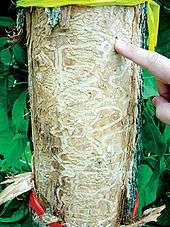
Outside its native range, emerald ash borer is an invasive species that is highly destructive to ash trees in its introduced range.[21] Prior to emerald ash borer being found in North America, very little was known about the insect in its native range aside from a short description of life-history traits and taxonomic descriptions, which resulted in focused research on its biology in North America.[7] The insect was first identified in Canton, Michigan, in 2002, but it may have been in the U.S. since the late 1980s.[22] It is suspected that it was introduced from overseas in shipping materials such as packing crates.[23]
Without factors that would normally suppress emerald ash borer populations in its native range (e.g., resistant trees, predators, and parasitoid wasps), populations can quickly rise to damaging levels.[7] After initial infestation, all ash trees are expected to die in an area within 10 years without control measures.[7] Every North American ash species has susceptibility to emerald ash borer, as North American species planted in China also have high mortality from infestations, but some Chinese ash species are resistant.[24][25]
Green ash and black ash trees are preferred by emerald ash borer. White ash is also killed rapidly but usually only after all green and black ash trees are eliminated. Blue ash is known to exhibit a higher degree of resistance to emerald ash borer, which is believed to be caused by the high tannin content in the leaves making the foliage unpalatable to the insect. While most Asian ashes have evolved this defense, it is absent from American species other than blue ash. Researchers have examined populations of so-called "lingering ash", trees that survived ash borer attack with little or no damage, as a means of grafting or breeding new, resistant stock. Many of these lingering ashes were found to have unusual phenotypes that may result in increased resistance. Aside from their higher tannin content, Asian ashes also employ natural defenses to repel, trap, and kill emerald ash borer larvae. Although studies of American ashes have suggested that they are capable of mustering similar defensive mechanisms, the trees do not appear to recognize when they are under attack.[26] Many of the specialized predators and parasitoids that suppressed emerald ash borer in Asia were not present in North America. Predators and parasitoids native to North America do not sufficiently suppress emerald ash borer, so populations continue to grow. Birds such as woodpeckers feed on emerald ash borer larva, although the adult beetles have not been used by any American fauna as food.[7] Emerald ash borer populations can spread between 2.5 to 20 km (1.6 to 12.4 mi) per year.[7] It primarily spreads through flight or by transportation of ash bark containing products such as firewood or nursery stock, which allows it to reach new areas and create satellite populations outside of the main infestation.[7][9]
Other factors can limit spread. Winter temperatures of approximately −38 °C (−36 °F) limit range expansion.,[27][28] and overwintering emerald ash borer survive down to average temperatures of −30 °C (−22 °F) because of antifreeze chemicals in the body and insulation provided by tree bark.[9] Larvae can also survive high heat up to 53 °C (127 °F). Conversely, much like ashes grown in the nursery trade, the population of emerald ash borer in North America is believed to have originated from a single group of insects from central China and also exhibits low genetic diversity.[9]
North American predators and parasitoids can occasionally cause high emerald ash borer mortality, but generally offer only limited control. Mortality from native woodpeckers is variable. Parasitism by parasitoids such as Atanycolus cappaerti can be high, but overall such control is generally low.[7]
Environmental and economic impacts
Emerald ash borer threatens the entire North American genus Fraxinus. It has killed tens of millions of ash trees so far and threatens to kill most of the 8.7 billion ash trees throughout North America.[11] Emerald ash borer kills young trees several years before reaching their seeding age of 10 years.[7] In both North America and Europe, the loss of ash from an ecosystem can result in increased numbers of invasive plants, changes in soil nutrients, and effects on species that feed on ash.[9]
Damage and efforts to control the spread of emerald ash borer have affected businesses that sell ash trees or wood products, property owners, and local or state governments.[7] Quarantines can limit the transport of ash trees and products, but economic impacts are especially high for urban and residential areas because of treatment or removal costs and decreased land value from dying trees.[29] Costs for managing these trees can fall upon homeowners or local municipalities. For municipalities, removing large numbers of dead or infested trees at once is costly, so slowing down the rate at which trees die through removing known infested trees and treating trees with insecticides can allow local governments more time to plan, remove, and replace trees that would eventually die. This strategy saves money as it would cost $10.7 billion in urban areas of 25 states over 10 years, while removing and replacing all ash trees in these same areas at once would cost $25 billion.[29][30] Some urban areas such as Minneapolis have large amounts of ash with slightly more than 20% of their urban forest as ash.[31]
Monitoring
In areas where emerald ash borer has not yet been detected, surveys are used to monitor for new infestations. Visual surveys are used to find ash trees displaying emerald ash borer damage, and traps with colors attractive to emerald ash borer, such as purple or green, are hung in trees as part of a monitoring program.[7] These traps can also have volatile pheromones applied to them that attract primarily males.[8]
Sometimes trees are girdled to act as trap trees to monitor for emerald ash borer. The stressed tree attracts egg-laying females in the spring, and trees can be debarked in the fall to search for larvae.[7] If detected, an area is often placed under a quarantine to prevent infested wood material from causing new infestations.[22][7] Further control measures are then taken within the area to slow population growth by reducing beetle numbers, preventing them from reaching reproductive maturity and dispersing, and reducing the abundance of ash trees.[7]
Government agencies in both the U.S. and Canada have utilized a native species of parasitoid wasp, Cerceris fumipennis, as a means of detecting areas to which emerald ash borer has spread. The females of these wasps hunt other jewel beetles and emerald ash borer if it is present. The wasps stun the beetles and carry them back to their burrows in the ground where they are stored until the wasps’ eggs hatch and the wasp larvae feed on the beetles. Volunteers catch the wasps as they return to their burrows carrying the beetles to determine whether emerald ash borer is present. This methodology is known as biological surveillance, as opposed to biological control, because it does not appear that the wasps have a significant negative impact on emerald ash borer populations.[32]
Management
In areas where emerald ash borer is non-native and invasive, quarantines, infested tree removal, insecticides, and biological control are used to reduce damage to ash trees.
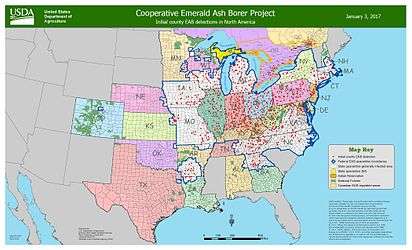
Quarantine and tree removal
Once an infestation is detected, quarantines are typically imposed by state or national government agencies disallowing transport of ash firewood or live plants outside of these areas without permits indicating the material has been inspected or treated (i.e., heat treatment or wood chipping) to ensure no live emerald ash borer are present in the bark and phloem.[22][33] In urban areas, trees are often removed once an infestation is found to reduce emerald ash borer population densities and the likelihood of further spread. Urban ash are typically replaced with non-ash species such as maple, oak, or linden to limit food sources.[34] In rural areas, trees can be harvested for lumber or firewood to reduce ash stand density, but quarantines may apply for this material, especially in areas where the material could be infested.[35]
Kentucky Extension specialists suggest selecting uncommon species to replace removed ashes in the landscape.[36] Previous generations created monocultures by planting ash trees in an overabundance, a factor in the extent of the devastation caused by the emerald ash borer. Favoring instead a diversity in species helps keep urban forests healthy. University of Kentucky scientists suggest choosing monotypic species such as the pawpaw, yellowwood, Franklin tree, Kentucky coffeetree, Osage orange, sourwood, and baldcypress.
Insecticides
Insecticides with active ingredients such as azadirachtin, imidacloprid, emamectin benzoate, and dinotefuran are currently used. Dinotefuran and imidacloprid are systemic (i.e., incorporated into the tree) and remain effective for one to three years depending on the product.[7][37][38] Insecticides are typically only considered a viable option in urban areas with high value trees near an infestation.[37] Ash trees are primarily treated by direct injection into the tree or soil drench. Some insecticides cannot be applied by homeowners and must be applied by licensed applicators. Damage from emerald ash borer can continue to increase over time even with insecticide applications.[7] Insecticide treatments are not feasible for large forested areas outside of urban areas.[7]
Biological control
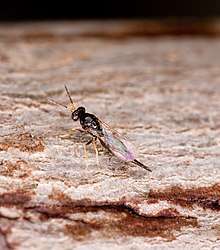
The native range of emerald ash borer in Asia was surveyed for parasitoid species that parasitize emerald ash borer and do not attack other insect species in the hope they would suppress populations when released in North America.[39] Three species imported from China were approved for release by the USDA in 2007 and in Canada in 2013: Spathius agrili, Tetrastichus planipennisi, and Oobius agrili, while Spathius galinae was approved for release in 2015.[40][41] Excluding Spathius galinae, which has only recently been released, the other three species have been documented parasitizing emerald ash borer larvae one year after release, indicating that they survived the winter, but establishment varied among species and locations.[41] Tetrastichus planipennisi and Oobius agrili established and have had increasing populations in Michigan since 2008; Spathius agrili has had lower establishment success in North America, which could be caused by a lack of available emerald ash borer larvae at the time of adult emergence in spring, limited cold tolerance, and better suitability to regions of North America below the 40th parallel.[41]
The USDA is also assessing the application of Beauveria bassiana, an insect fungal pathogen, for controlling emerald ash borer in conjunction with parasitoid wasps.[42]
See also
- Forest integrated pest management
- Forest pathology
- Chestnut blight
- Dutch Elm Disease
- Invasive species
References
- "Data Sheets on Quarantine Pests: Agrilus planipennis" (PDF). OEPP/EPPO Bulletin. 35 (3): 436–438. 2005. doi:10.1111/j.1365-2338.2005.00844.x. Archived from the original (PDF) on 2013-12-03. Retrieved 2013-08-28.
- Miller, Matthew. "Battle of the Ash Borer: Decades after Beetles Arrived in Michigan, Researchers Looking to Slow Devastation". Lansing State Journal.
- Parsons, Gary L. (November 2008). "Emerald ash borer: A guide to identification and comparison to similar species" (PDF). USDA. Retrieved August 15, 2014.
- "Native Borers and Emerald Ash Borer Look-alikes" (PDF). Michigan State University Extension. Retrieved 12 March 2017.
- Volkovitsh, Mark G.; Orlova-Bienkowskaja, Marina J.; Kovalev, Alexey V.; Bieńkowski, Andrzej O. (2019). "An illustrated guide to distinguish emerald ash borer (Agrilus planipennis) from its congeners in Europe". Forestry: An International Journal of Forest Research. doi:10.1093/forestry/cpz024.
- Gould, Juli S.; Bauer, Leah S.; Lelito, Jonathan; Duan, Jian (May 2013). "Emerald Ash Borer Biological Control Release and Recovery Guidelines" (PDF). USDA-APHIS-ARS-FS. Cite journal requires
|journal=(help) - Herms, Daniel A.; McCullough, Deborah G. (October 2013). "Emerald Ash Borer Invasion of North America: History, Biology, Ecology, Impacts, and Management" (PDF). Annual Review of Entomology. 59: 13–30. doi:10.1146/annurev-ento-011613-162051. PMID 24112110.
- Poland, Therese. M; Chen, Tigen; Jennifer, Koch; Pureswaran, Deepa (December 2014). "Review of the emerald ash borer (Coleoptera: Buprestidae), life history, mating behaviours, host plant selection, and host resistance" (PDF). The Canadian Entomologist. 147 (3): 252–262. doi:10.4039/tce.2015.4.
- Valenta, V.; et al. (2016). "A new forest pest in Europe: a review of Emerald ash borer (Agrilus planipennis) invasion". Journal of Applied Entomology. 141 (7): 507–526. doi:10.1111/jen.12369.
- "Agrilus planipennis (insect)". Global Invasive Species Database. ISSG-IUCN. August 14, 2006.
- "Emerald ash borer". USDA Forest Service. Retrieved July 5, 2015.
- Peter A. Thomas (2016). "Biological Flora of the British Isles: Fraxinus excelsior". Journal of Ecology. 104 (4): 1158–1209. doi:10.1111/1365-2745.12566.
- "Ash tree set for extinction in Europe". BBC. 23 March 2016. Retrieved 23 March 2016.
- Marina J. Orlova-Bienkowskaja; Alexander N. Drogvalenko; Ilya A. Zabaluev; Alexey S. Sazhnev; Elena Yu. Peregudova; Sergey G. Mazurov; Evgenij V. Komarov; Andrzej O. Bieńkowski (2019). "Bad and good news for ash trees in Europe: alien pest Agrilus planipennis has spread to the Ukraine and the south of European Russia, but does not kill Fraxinus excelsior in the forests". doi:10.1101/689240. Retrieved 22 July 2019. Cite journal requires
|journal=(help) - "Emerald ash borer (Agrilus planipennis)". Department of Agriculture, Environment and Rural Affairs. Retrieved 22 July 2019.
- Drogvalenko, Alexander N.; Orlova-Bienkowskaja, Marina J.; Bieńkowski, Andrzej O. (2019-09-16). "Record of the Emerald Ash Borer (Agrilus planipennis) in Ukraine is Confirmed". doi:10.20944/preprints201909.0174.v1. Cite journal requires
|journal=(help) - "Presence of Agrilus planipennis confirmed in Ukraine". EPPO. 2019. Retrieved 31 December 2019.
- Wang, Xiao-Yi; et al. (2010). "The biology and ecology of the emerald ash borer, Agrilus planipennis, in China". Journal of Insect Science. 10 (128): 128. doi:10.1673/031.010.12801. PMC 3016904. PMID 20879922.
- Poland, T.; McCullough, D. (2006). "Emerald ash borer: invasion of the urban forest and the threat to North America's ash resource" (PDF). Journal of Forestry. 104: 118–124.
- "Emerald Ash Borer attacking White Fringe Tree". November 2, 2014. Archived from the original on May 7, 2015. Retrieved 14 December 2014.
- "Agrilus planipennis (insect)". Global Invasive Species Database. ISSG-IUCN. August 14, 2006. Retrieved August 28, 2013.
- "Initial County EAB detections in North America" (PDF). USDA. Retrieved 28 January 2017.
- Cappaert, D.; et al. (Fall 2005). "Emerald ash borer in North America: a research and regulatory challenge". American Entomologist. 51 (3): 152–163. doi:10.1093/ae/51.3.152.
- Lui, Houping; et al. (2003). "Exploratory survey for the emerald ash borer, Agrilus planipennis (Coleoptera: Buprestidae), and its natural enemies in China" (PDF). Great Lakes Entomologist. 36: 191–204. Retrieved 28 May 2014.
- Rebek, E. J.; Herms, D. A.; Smitley, D. R.; et al. (2013). "Interspecific Variation in Resistance to Emerald Ash Borer (Coleoptera: Buprestidae) Among North American and Asian Ash (Fraxinus spp.)" (PDF). Environmental Entomology. 37 (1): 242–246. doi:10.1603/0046-225X(2008)37[242:IVIRTE]2.0.CO;2. PMID 18348816. Archived from the original (PDF) on March 4, 2016.
- Anulewicz, Andrea C.; McCullough, Deborah G.; Cappaert, David L. (September 2007). "Emerald Ash Borer (Agrilus planipennis) Density and Canopy Dieback in Three North American Ash Species". Arboriculture & Urban Forestry. 33 (5): 338–349. doi:10.1007/s10530-013-0543-7.
- DeSantis, Ryan D.; et al. (April 21, 2013). "Effects of climate on emerald ash borer mortality and the potential for ash survival in North America". Agricultural and Forest Meteorology. 178: 120.
- "The Upside Of The Bitter Cold: It Kills Bugs That Kill Trees". National Public Radio. Retrieved May 21, 2014.
- McCullough, D.G.; et al. (2012). "Evaluation of potential strategies to SLow Ash Mortality (SLAM) caused by emerald ash borer (Agrilus planipennis): SLAM in an urban forest" (PDF). International Journal of Pest Management. 58: 9–23. doi:10.1080/09670874.2011.637138.
- Kovacs, K. F.; et al. (September 2009). "Cost of potential emerald ash borer damage in U.S. communities, 2009-2019" (PDF). Ecological Economics. 69 (3): 569–578. doi:10.1016/j.ecolecon.2009.09.004. Archived from the original (PDF) on April 7, 2014.
- "Emerald Ash Borer (EAB) is in Minneapolis". Minneapolis Park and Recreation Board. Archived from the original on August 8, 2013. Retrieved August 29, 2013.
- Careless, Philip; Marshall, Stephen. A.; Gill, Bruce D.; et al. (February 2014). "The use of Cerceris fumipennis (Hymenoptera: Crabronidae) for surveying and monitoring emerald ash borer (Coleoptera: Buprestidae) infestations in eastern North America". Canadian Entomologist. 146: 90–105. doi:10.4039/tce.2013.53.
- "Moving Firewood". USDA. Retrieved 28 January 2017.
- "Ash replacement information". USDA Forest Service. Retrieved July 15, 2014.
- "SLAM: SLow Ash Mortality". Archived from the original on March 2, 2015.
- "After Your Ash Has Died: Making an Informed Decision on What to Replant" (PDF). extension.ca.uky.edu.
- Herms, Daniel A.; McCullough, Deborah G.; Smitley, David R.; Sadof, Clifford S.; Williamson, R. Chris; Nixon, Phillip L. (June 2009), "Insecticide Options for Protecting Ash Trees from Emerald Ash Borer" (PDF), North Central IPM Center Bulletin: 12, retrieved August 30, 2013
- Hahn, Jeffrey; Herms, Daniel A.; McCullough, Deborah G. (February 2011), Frequently Asked Questions Regarding Potential Side Effects of Systemic Insecticides Used to Control Emerald Ash Borer (PDF), www.emeraldashborer.info, retrieved August 30, 2013
- Bauer, L.S.; Liu, H-P; Miller, D.; Gould, J. (2008). "Developing a classical biological control program for Agrilus planipennis (Coleoptera: Buprestidae), an invasive ash pest in North America" (PDF). Newsletter of the Michigan Entomological Society. 53 (3&4): 38–39.
- "Biological Control of the Emerald Ash Borer". United States Department of Agriculture Forest Service.
- Bauer, Leah S.; Duan, Jian J.; Gould, Juli R.; van Driesche, Roy; et al. (March 8, 2015). "Progress in the classical biological control of Agrilus planipennis Fairmaire (Coleoptera:Bupresitdae) in North America". The Canadian Entomologist. 147 (3): 300–317. doi:10.4039/tce.2015.18.
- "Biocontrol: Fungus and Wasps Released to Control Emerald Ash Borer". Science News. Science Daily. May 2, 2011. Retrieved August 30, 2013.
External links
| Wikimedia Commons has media related to Agrilus planipennis. |
| Wikispecies has information related to Agrilus planipennis |
- Interview with researcher
- Canadian Food Inspection Agency
- USDA Forest Service Northern Research Station link to research on EAB
- Species Profile- Emerald Ash Borer (Agrilus planipennis), National Invasive Species Information Center, United States National Agricultural Library. Lists general information and resources for Emerald Ash Borer.
- The short film Emerald Ash Borer: The Green Menace is available for free download at the Internet Archive